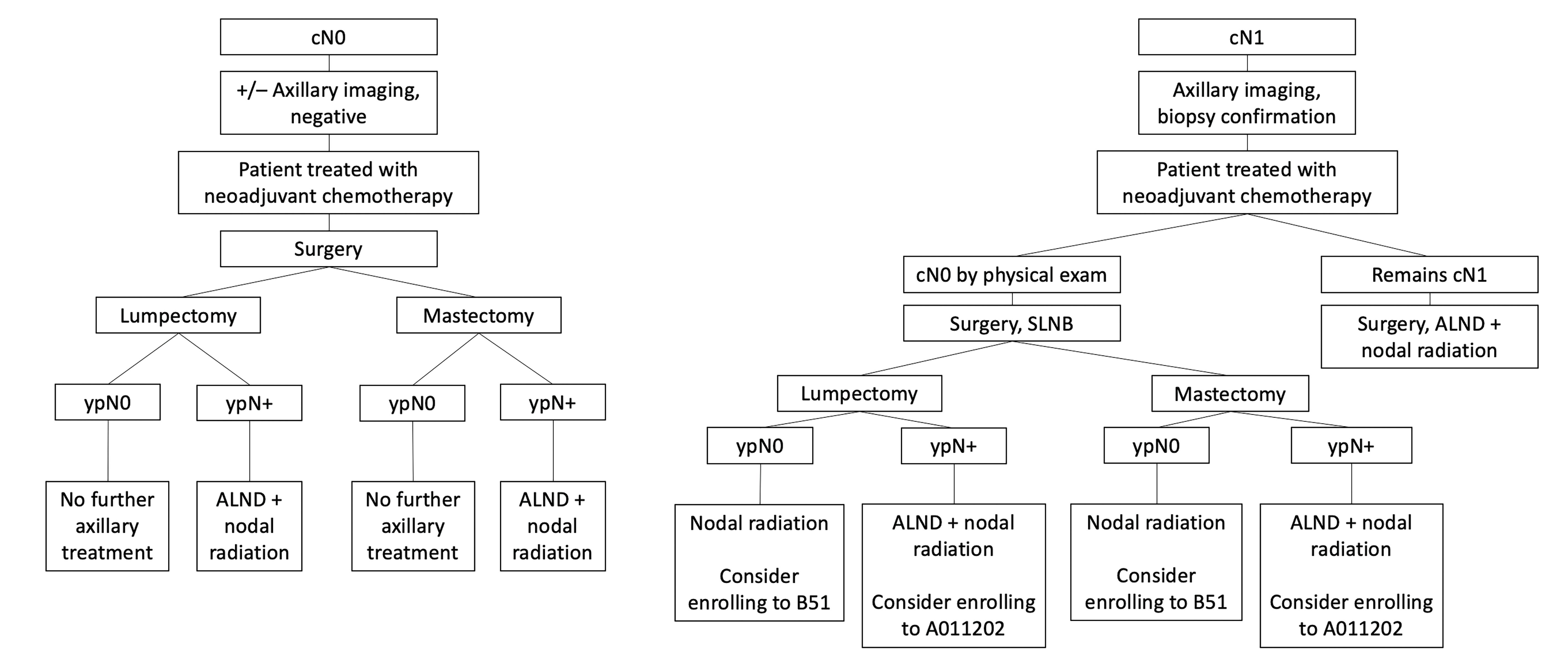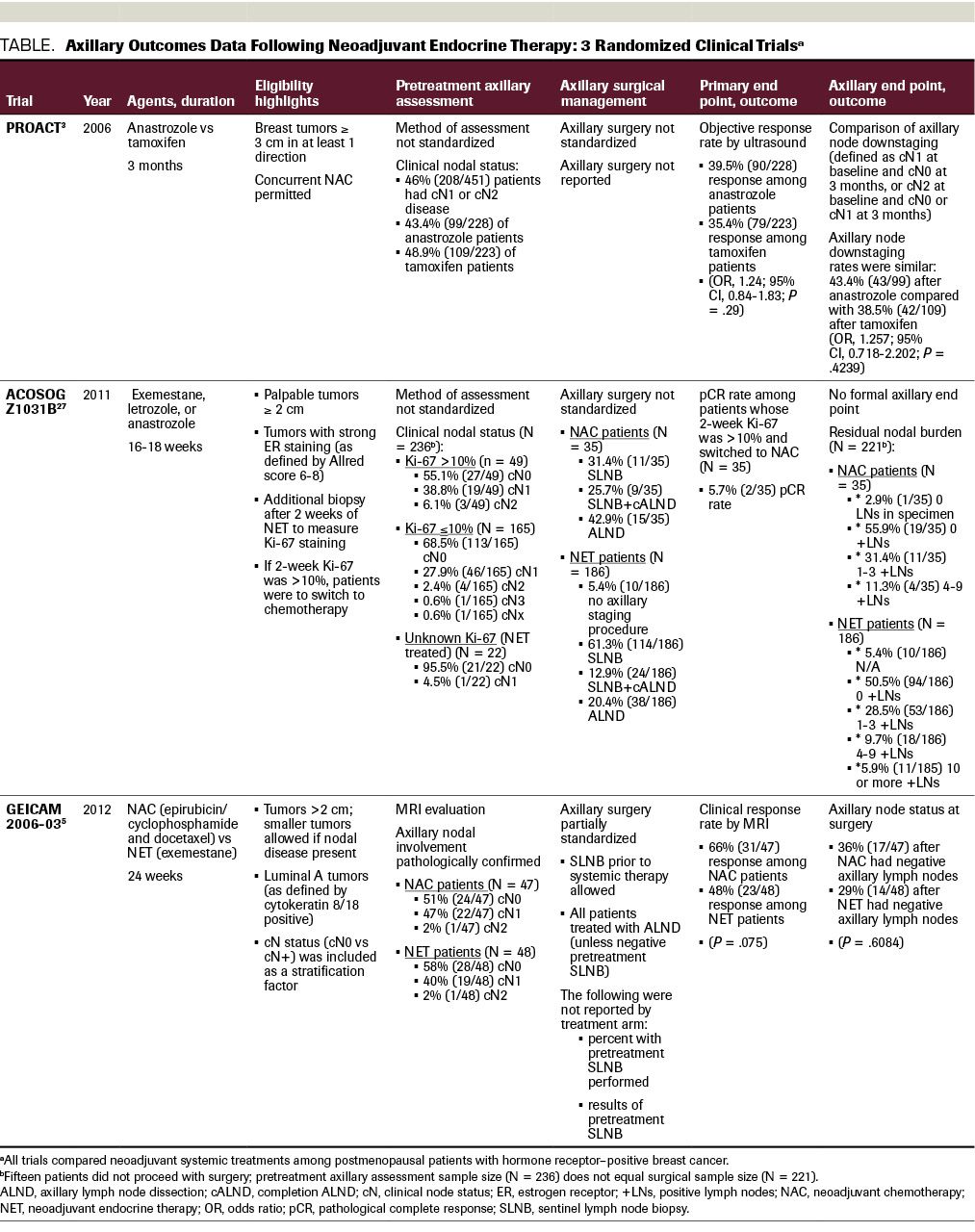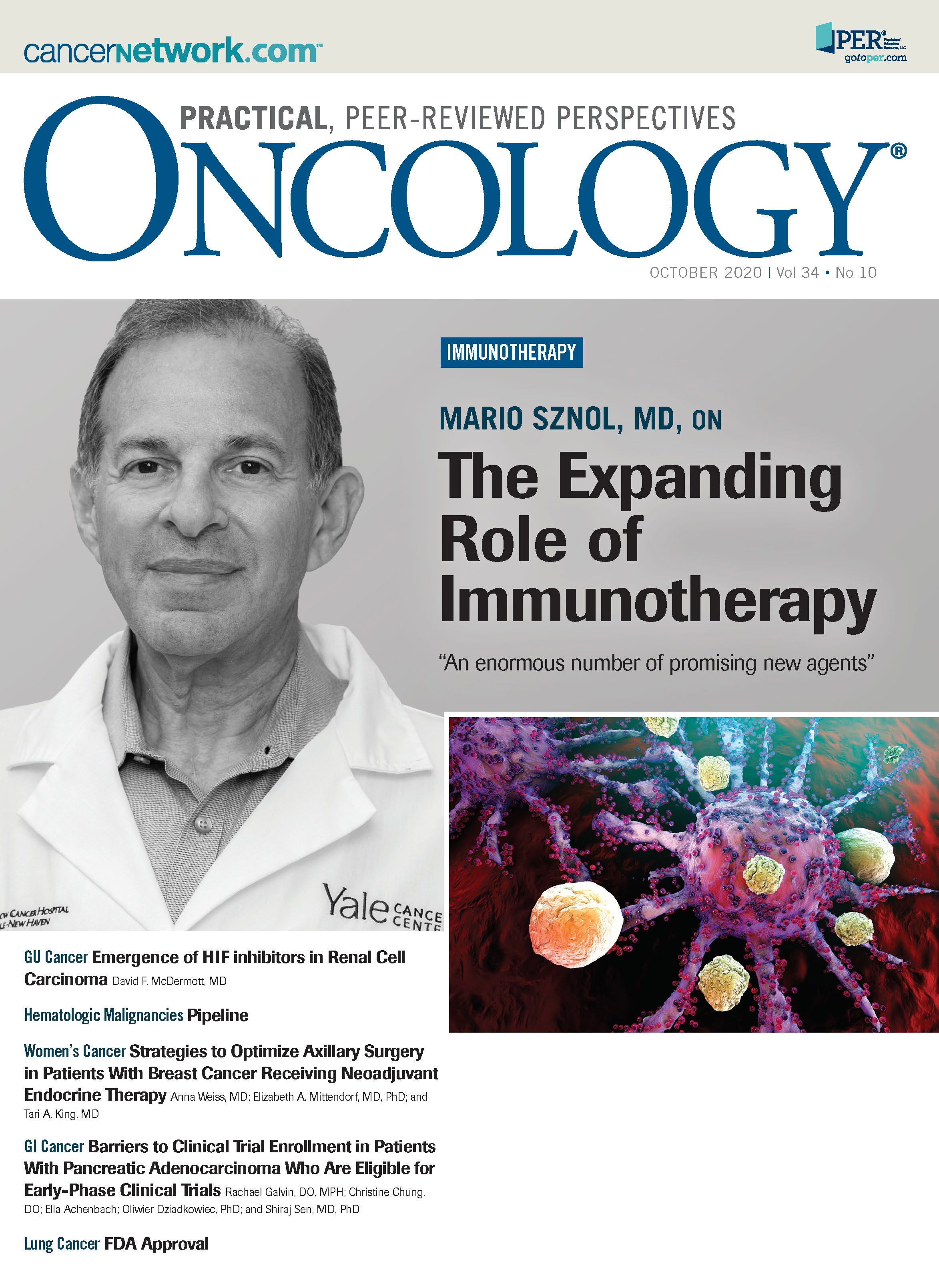Strategies to Optimize Axillary Surgery in Patients With Breast Cancer Receiving Neoadjuvant Endocrine Therapy
ABSTRACT Current guidelines for axillary surgery following systemic therapy do not differentiate between neoadjuvant endocrine therapy (NET) and neoadjuvant chemotherapy (NAC). Without specific guidelines, many assume that axillary surgery after NET should mirror that after NAC; however, NET has traditionally been used for patients with biologically favorable disease, so alternative axillary surgery strategies may be appropriate. Unfortunately, clinical trials that have examined NET have not rigorously studied axillary management or outcomes. The limited observational data available reveal that axillary lymph node dissection (ALND) is less frequently performed for positive nodes following NET than NAC; ALND rates after NET are more like those of upfront surgery patients. Although outcomes of omitting ALND after NET in patients who remain node positive are unknown, hypothesis-generating work from the National Cancer Database suggests that most patients selected for NET have limited nodal burden, and the prognostic significance of residual nodal disease after NET may not carry the same implications as residual disease after NAC. As such, there is opportunity to define axillary surgery strategies after NET that differ from those used after NAC.
Weiss is an associate surgeon, Division of Breast Surgery, Department of Surgery, Brigham and Women's Hospital and Breast Oncology program, Dana Farber/Brigham and Women's Cancer Center.

Mittendorf if the Robert and Karen Hale Distinguished Chair in Surgical Oncology and Associate Chair for Research in the Department of Surgery at Brigham and Women's Hospital.

King is the Anne E. Dyson Professor of Surgery at Harvard Medical School, the chief of the Division of Breast Surgery and the associate chair of multidisciplinary oncology in the Department of Surgery at Brigham and Women's Hospital.

Introduction
The increasing use of neoadjuvant systemic therapy has allowed surgeons to tailor local-regional treatment strategies in breast cancer, resulting in increased opportunities for breast conservation and decreased need for axillary lymph node dissection (ALND).1 In contrast to patients with HER2-positive or triple-negative disease, patients with hormone receptor (HR)-positive breast cancer experience low pathologic complete response (pCR) rates after neoadjuvant chemotherapy (NAC), leading to challenges in selecting the appropriate preoperative therapy when patients are not suitable candidates for upfront surgery.1,2 Clinical trials have demonstrated that neoadjuvant endocrine therapy (NET) can effectively downsize HR-positive tumors and improve breast conservation rates3-5; however, axillary management strategies and outcomes have been largely underreported. Patients treated with NET were not included in the large trials examining sentinel lymph node biopsy (SLNB) following preoperative therapy6-8 and they are also excluded from ongoing clinical trials investigating (1) whether patients who experience a nodal pCR after NAC benefit from regional nodal radiation,9 and (2) if axillary radiation provides comparable local regional control to ALND for patients with residual nodal disease after NAC.10
Given the limited available data, guidelines for axillary management after NET have been largely extrapolated from the NAC population11; yet recent work from our group and others has demonstrated significant variation in clinical practice. Current trends demonstrate a modest increase in use of NET to optimize breast conservation12,13; we hypothesize that increased use of genomic assays for treatment selection14 as well as the recent coronovirus disease 2019 (COVID-19) crisis will result in the continuation of this trend, highlighting the need for thoughtful consideration of post-NET axillary management strategies. Here, we summarize available data and propose an algorithm for surgical management of the axilla following NET.
Current Standards for Axillary Management After NET
NET has traditionally been limited to older patients with favorable tumor biology,15 a population in whom less treatment, including omission of axillary surgery, has been deemed appropriate.16 However, there is growing interest in NET,12 including clinical trials investigating NET in younger patients who would otherwise be candidates for NAC or primary surgery.5,17,18 The National Comprehensive Cancer Network (NCCN) guidelines for surgical axillary staging do not distinguish between NET and NAC.11 Thus, among patients fit for surgery being treated with curative intent, surgical management of the axilla after NET has been largely extrapolated from algorithms developed for the NAC population (Figure 1). SLNB is the accepted surgical staging procedure following systemic therapy among both clinically node-negative (cN0)19 and clinically node-positive (cN1) populations, provided there has been an adequate clinical response.6-8 Residual nodal disease of any size detected on SLNB after NAC has been shown to confer a high likelihood of additional disease in nonsentinel lymph nodes, and completion ALND (cALND) remains standard.8,20
Data to support the application of NAC axillary management algorithms to patients who receive NET are limited. A Swedish prospective multicenter trial that investigated the feasibility of SLNB after neoadjuvant systemic therapy in 195 patients with cT1-4d, N1 breast cancer included only 1 patient treated with NET.21 A single-institution prospective feasibility trial from Japan included 36 cN0-1 patients with unknown receptor status, 16 of whom were treated with NET.22 SLNB was technically successful in 100% of the NET-treated patients and 85% (17/20) of the NAC-treated patients. Eight patients declined cALND after negative SLNB, but the false-negative rate among the remaining 25 patients was 4% (1/25) overall, 0% following NET and 8% (1/12) following NAC, leading authors to conclude that SLNB after NET is as feasible as SLNB after NAC. Two single-institution retrospective reviews of prospectively maintained databases examined the oncologic safety of performing SLNB after systemic therapy, including NET, and omitting cALND based on negative SLNB results.23,24 Chang et al23 reported similar 5-year local-regional recurrence-free survival among patients who were treated with SLNB, SLNB followed by cALND for positive nodes, or ALND (P = .33). This study included 198 patients treated with NAC or NET between 2002 and 2015, but did not specify the number treated with NET vs NAC. Galimberti et al24 examined 396 patients with cT1-4N0-2 breast cancer of any subtype who were treated with neoadjuvant systemic therapy between 2000 and 2010; 56 were treated with NET (48 cN0 and 8 cN1/2). Five-year overall survival (OS) was comparable between patients with pathologic node-negative (ypN0) disease treated with SLNB and patients with pathologic node-positive (ypN+) disease treated with cALND: 92.2% (95% CI, 88.5%-93.9%) and 88.7% (95% CI, 83.7%-93.6%), respectively. Study authors deemed SLNB after systemic therapy acceptable in the cN1/2 population; results were not reported separately for NET- vs NAC-treated patients.
Figure 1: The current standards for axillary management for patients treated with neoadjuvant systemic therapy, both chemotherapy and endocrine therapy alike. However, it is important to note that those treated with neoadjuvant endocrine therapy do not meet inclusion criteria for these clinical trials.

Despite NCCN guidelines that patients treated with neoadjuvant systemic therapy who have positive sentinel lymph nodes should undergo cALND, our group has recently reported significant variation with respect to axillary management after NET. In a National Cancer Database (NCDB) analysis of stage II-III HR-positive breast cancer patients,13 axillary management following NET more closely aligned with upfront surgery patients than with those receiving NAC. Specifically, we reported similar rates of axillary staging with SLNB among patients treated with NET and those having upfront surgery (odds ratio [OR], 1.01; 95% CI, 0.87-1.18 for cN0 patients; and OR, 0.95; 95% CI, 0.80-1.13 for cN1). Among patients found to have positive sentinel nodes, NET patients were less likely to undergo cALND than upfront surgery patients (the OR of omitting ALND was 1.31; 95% CI, 1.04-1.64, for cN0 patients treated with NET as compared with upfront surgery patients; and OR, 1.45, 95% CI, 1.00-2.10, for cN1 patients treated with NET). While omitting cALND in this scenario diverges from current guidelines as outlined above, given the known selection biases in the use of NET (ie, patients selected for NET in this NCDB cohort were older, more frequently had favorable tumor biology, and less frequently had cN1 disease),13 these findings suggest that perhaps the observed axillary treatment patterns represent what surgeons consider “right-size” therapy following NET.
Clinical Trial Data Addressing Nodal Disease After NET
Robust clinical trial data have demonstrated the benefit of NET to downsize breast tumors,25 but trials have not rigorously studied axillary outcomes. A prospective single-arm trial by Olson et al,26 specifically aimed at improving surgical outcomes with NET, treated 115 postmenopausal patients with stage II-III HR-positive breast cancer with 16 to 24 weeks of preoperative letrozole. Presenting nodal status was determined by physical exam without prescribed imaging, and breast and axillary surgery were determined by surgeon and patient preference. Of the patients who completed therapy, 62% (62/106) were cN0, 32% (34/106) were cN1, and 6% (6/106) were cN2. Overall, 98% (94/96) had axillary surgery, but the specific procedures were not specified, making it difficult to draw conclusions about management of the axilla. The sparse randomized clinical trial data available are presented in the Table. Although these trials often failed to standardize axillary assessments and surgeries, there is opportunity to learn how surgeons tend to treat the axilla by reviewing the few prospective NET trials that have reported axillary management and outcomes.
Table: Axillary Outcomes Data Following Neoadjuvant Endorcine Therapy: 3 Randomized Clinical Trials

The phase 3 trial PROACT3 randomized 451 postmenopausal patients with HR-positive T2-4 N0-2 M0 breast cancer to 3 months of anaztrozole or tamoxifen, with concomitant NAC permitted. The trial’s axillary end point was axillary node downstaging (defined as cN1 to cN0, or cN2 to cN0-1 after treatment). Patients randomized to anastrozole had presenting clinical nodal status (43.4% [99/228] cN1-2) similar to those randomized to tamoxifen (48.9% [109/223] cN1-2). Axillary node downstaging rates were also similar between groups: 43.4% (43/99) after anastrozole and 38.5% (42/109) after tamoxifen (OR, 1.26; 95% CI, 0.72-2.20; P = .42). Unfortunately, PROACT did not standardize nor report details of the axillary surgery performed or final pathologic node status, making it difficult to provide axillary management guidance or advance understanding of residual nodal disease after NET.
The American College of Surgeons Oncology Group (ACOSOG) Z1031 trial4 was a 2-part study examining choice of NET (part A) and testing the hypothesis that Ki-67 could be used to assess response to NET (part B). In part A, 374 patients with estrogen receptor (ER)-positive, cT2-4N0-3 breast cancer were randomized to 16 to 18 weeks of 1 of 3 aromatase inhibitors (letrozole, anastrozole, or exemestane) to determine the optimal agent for use in future trials.4 In part B, 245 patients were randomized to the same 3 agents, then subjected to a core biopsy for immunohistochemical analysis of Ki-67 staining at 2 weeks. Patients with Ki-67 staining >10% were switched to NAC.27 Forty-nine patients had Ki-67 staining >10% but only 35 patients accepted protocol treatment with NAC. Axillary assessments and surgery were not prespecified, but part B of the trial reported surgical details and volume of residual nodal disease. Of the NET patients, 33.3% (62/186) were treated with ALND and 44.1% (82/186) were ypN+. Of patients switched to NAC, 68.6% (24/35) were treated with ALND and 42.7% (15/35) had ypN+ disease. Thus, ALND rates were lower for NET patients, although rates of ypN+ disease were similar between the 2 groups. Because management was not standardized, these findings are difficult to interpret but may suggest treatment bias to perform less axillary surgery in NET patients.
The Spanish Breast Cancer GROUP (GEICAM) 2006-03 study was a phase 2 clinical trial that randomized 95 pre- and postmenopausal patients with luminal A (ER-positive, progesterone receptor–positive, cytokeratin 8/18–positive) breast cancer to 24 weeks of NAC or NET.5 All patients’ breasts/axillae were evaluated with MRI, baseline nodal involvement was confirmed by biopsy (SLNB allowed), and ALND was mandated for all patients unless pretreatment SLNB negative. Overall, 49% (22/47) of NAC and 44% (21/48) of NET patients presented with cN1/2 disease, and clinical nodal response to preoperative therapy was comparable between groups. The trial’s axillary outcome, ypN status, was similar among groups: 36% (17/47) were ypN0 after NAC, and 29% (14/48) were ypN0 after NET (P = .6084). Only 1 patient in either arm experienced an overall pCR.
As expected, overall pCR rates were consistently low in these studies: 2% after NET and NAC in GEICAM/2006-03, and 5.7% after NAC in ACOSOG Z1031. Similarly, NEOCENT,28 a feasibility trial that randomized 44 postmenopausal women with ER-rich tumors to NAC or NET (letrozole), reported a 0% overall pCR rate in both arms as a secondary end point. In a trial that randomized 239 postmenopausal breast cancer patients to standard NAC vs NET (exemestane or anastrozole), Semiglazov et al reported breast pCR as an exploratory end point: 6% after NAC and 3% after NET (P not significant).29 Newer trials studying the addition of targeted agents like CDK4/6 inhibitors to NET have also reported low overall pCR rates of 1% to 2%.30,31 Since it is unlikely that HR-positive patients treated with NET will experience a pCR, perhaps it is not a clinically meaningful end point for HR-positive patients.
Filling the Gaps in Knowledge
Unlike in the NAC population, for whom residual nodal disease has been well studied20 and recognized as an independent prognostic factor among all breast cancer subtypes,32 there are minimal data regarding the burden and prognostic significance of residual nodal disease following NET. Our group hypothesized that minimal residual nodal burden after NET would not have a detrimental impact on long-term outcomes, because patients selected for NET have not received their full complement of systemic therapy at the time of surgery. To test this hypothesis, the NCDB was queried for cT1-3N0-1 HR-positive breast cancer patients treated with NET and axillary surgery between 2010 and 2016. Similar to historic studies in the upfront surgery population,33 the presence of small volume residual disease after NET (ypN0[i+] and ypN1mi) had no effect on 5-year adjusted OS. OS was impacted by the presence of residual macrometastatic disease (ypN1) following NET. In a propensity matched analysis, 5-year OS was similar between patients selected for NET and those proceeding to upfront surgery and found to have low-volume nodal disease.34
These data led us to further investigate the implications of choice of axillary surgery after NET. Specifically, we sought to test the hypothesis that SLNB could be used after NET to identify patients with a low residual nodal disease burden who could safely avoid ALND. To address this question, we interrogated our prospectively maintained single-institution database (December 2015- September 2018; N = 95) and the NCDB (2012-2016; N = 3640) for patients with stage I-III HR-positive breast cancer who were treated with NET. Of the cN0 patients who underwent axillary surgery, the majority of patients had a low volume of residual nodal disease (defined as < 3 positive nodes): 96% (44/46) in the institutional cohort and 91% (2945/3227) in the NCDB cohort. To test the effect of axillary surgery, we analyzed the larger NCDB cohort and found that there was no difference in 5-year estimated OS by type of axillary surgery (SLNB vs ALND) in any residual nodal disease burden subgroup (ypN0; 1-2 positive nodes; ≥ 3 positive nodes). We also performed a subgroup analysis to examine the volume of residual nodal disease in patients presenting with cT1-2N0 disease who otherwise would have been eligible for the ACOSOG Z001135 or the European Organization for Research and Treatment of Cancer 10981-22023 AMAROS36 trials. Among these patients, 93% (2552/2732) had < 3 positive nodes. Again, there was no difference in OS between patients treated with SLNB or ALND (3-year estimated OS, 95.4% for both groups; P = .99).37
Collectively, these data suggest that most patients selected for NET have a low residual nodal disease burden after treatment, and the type of axillary surgery in these patients may not impact survival, just as SLNB and cALND are equivalent for cN0 patients who are selected for upfront surgery and found to have 1 to 2 positive nodes.35The accepted clinical benefit of NET is the potential to decrease the size of HR-positive breast tumors and optimize breast-conserving surgery; thus, these data should drive further clinical trials to investigate SLNB alone for patients treated with NET who are found to have low-volume residual nodal disease.
Figure 2: Suggested axillary management algorithm for hormone receptor–positive cN0 patients, treated with neoadjuvant endocrine therapy. While pretreatment axillary ultrasound is recommended, it is not critical for this algorithm, because these patients would have met Z0011/AMAROS criteria if surgery were their primary treatment (provided they have cT1-2 breast tumors).

Opportunity: Building an Axillary Management Algorithm Specific to NET
Several observations are made from this literature review: (1) SLNB after NET is reasonable in both cN0 and cN1 patient populations; (2) we do not expect a robust (if any) nodal response to NET; (3) the nodal burden among patients selected for NET may be similar to that of upfront surgery patients; and (4) the prognostic significance of residual pathologic nodal disease after NET is more similar to that of primary surgery patients than to that of patients treated with NAC. As previously mentioned, patients in prospective NET trials experienced very low pCR rates. As such, we do not expect NET to eradicate nodal disease; therefore, the lack of its ability to do so—ie, the presence of residual nodal disease after NET—should not mandate cALND. Moreover, while NAC patients have typically received the majority of their systemic therapy before surgery, NET patients have received only a small fraction of their overall course of therapy. These patients have an additional 5 to 10 years of endocrine therapy, just like upfront surgery patients.
When viewed in totality, analyses of our own data as well as of population-based data suggest that the majority of patients treated with NET have low residual nodal disease burden and that the type of axillary surgery performed may not affect long-term outcomes. This leads us to propose application of strategies derived from trials in upfront surgery patients with limited nodal disease, like ACOSOG Z001 and AMAROS, to NET patients. Suggested algorithms adopting these strategies for HR-positive patients treated with NET are presented in Figures 2 and 3. It should be noted that at our institution, we routinely obtain pretreatment axillary ultrasound for patients who we plan to treat with neoadjuvant systemic therapy, and we frequently obtain MRI pre-and post treatment to assess tumor response. Thus, we make rigorous attempts to identify patients with low-volume nodal disease, and thoughtfully deescalate axillary surgery in this highly selected NET population.
Figure 3: Suggested axillary management algorithm for hormone receptor–positive cN1 patients, treated with neoadjuvant endocrine therapy. This algorithm is predicated on thorough pretreatment axillary imaging, to include at least ultrasound, to characterize the patient’s presenting nodal disease burden, and to select patients with minimal nodal disease for thoughtful deescalation of axillary surgery.

Changing Landscape of Systemic Therapy for HR-Positive Disease: Challenges for Local Regional Management
The landscape of systemic therapy for HR-positive breast cancer is rapidly evolving. First, there is interest in new systemic therapy agents, including new targeted therapies for use in the neoadjuvant setting, and surgeons will be forced to make axillary management decisions without knowing the effect these agents may have on nodal disease. For example, several studies have examined the use of CDK 4/6 inhibitors in addition to NET,18,30,31 and there is growing enthusiasm for this approach given the improvements in invasive disease-free survival seen in the MONARCH E trial, which added abemaciclib to adjuvant endocrine therapy.38 While these agents effectively suppress cell proliferation, they do not appear to consistently augment clinical response30,31,39 and their impact on nodal assessment and response is unknown, which adds a layer of complexity to surgical decision-making. To further our understanding of the effects of CDK 4/6 inhibitors on nodal response, in anticipation of forthcoming NET clinical trials, our group (Weiss, Metzger et al) is currently examining axillary management and outcomes from the multi-institution randomized trial PELOPS, which is studying the effects of adding palbociclib to NET in both pre- and postmenopausal patients.18
Another example of the changing landscape of HR-positive breast cancer treatment includes refinement of patient selection criteria, as neoadjuvant regimen choice will increasingly be based on biologic rather than anatomic factors. Genomic assays like Oncotype DX predict chemotherapy benefit,40 and it stands to reason that this knowledge should be incorporated when choosing a neoadjuvant treatment strategy. The feasibility of using Oncotype DX41 to select patients for preoperative systemic therapy was demonstrated in a study by Bear et al.14 This prospective trial enrolled 64 patients with HR-positive breast cancer and triaged patients to NET or NAC based on their recurrence score. Patients with a score less than 11 were treated with NET, those with a score greater than 26 were treated with NAC, and those with a score between 11 and 25 were randomized to NET vs NAC. The primary end point was that less than one-third of the patients with a score between 11 and 25 would decline randomization. Only 5 of the 33 patients with a score between 11 and 25 (15%; 95% CI, 2.9%-27.4%) refused assignment; therefore, this strategy was considered successful, and the trial demonstrated that it was feasible to send a core biopsy specimen for molecular profiling and use the results to make a decision regarding neoadjuvant therapy.
We fully support the increased use of genomic assays for selection of preoperative therapy. Our institution (Tolaney et al) is currently enrolling HR-positive breast cancer patients to a prospective trial in which the PAM-50 assay is performed preoperatively with the primary aim of determining the extent to which genomic assay results change neoadjuvant therapy recommendations.42 As adjuvant systemic therapy is increasingly driven by genomic assay results and chemotherapy use has decreased in favor of endocrine therapy, we predict that neoadjuvant systemic therapy will mirror this trend and the practice of sending genomic assays in the neoadjuvant setting will likely expand the population of patients appropriate for NET. Figure 4 depicts factors taken into consideration when choosing a neoadjuvant systemic therapy regimen, including the suggestion that genomic assay recurrence scores should play a prominent role. Patients with cN0 or low-volume axillary disease at presentation, but who have large breast tumors and require tumor downsizing to achieve breast-conserving surgery, are particularly appropriate candidates for this low-oncotype/high-NET-use population. More research about axillary management and outcomes after NET is needed to develop axillary management standards specific to this population and to avoid surgical overtreatment of the axilla among patients whose primary motivation for neoadjuvant systemic therapy was to undergo less extensive surgery.
Figure 4: This figure depicts some of the factors taken into consideration when choosing a neoadjuvant systemic therapy regimen. These decisions are frequently based on a mix of clinical and biological tumor factors, and increasingly likely they will be based on genomic assay results.

Conclusions
Our proposed algorithm for surgical management of the axilla after NET is particularly timely in the setting of the COVID-19 pandemic. As the number of hospital admissions and critically ill patients rose, resources needed to be preserved, and nonurgent/elective operations were delayed. The COVID-19 Pandemic Breast Cancer Consortium43 presented expert opinion about the prioritization of breast cancer operations. HR-positive breast cancer was given low priority because these patients can be treated with NET without survival detriment. An unintended consequence of this delay strategy is that a surge of patients—those who would have normally undergone primary surgery and been eligible to omit ALND in the setting of 1 to 2 positive sentinel nodes (per Z0011 or AMAROS)—have now been treated with NET and are potentially subject to axillary management strategies employed after NAC. Given the very low anticipated rates of axillary pCR after NET and apparent lack of prognostic significance of low-volume residual nodal disease, applying guidelines used after NAC may result in overtreatment. Per the presented algorithms, omission of ALND should be considered for these HR-positive early breast cancer patients who have a low burden of residual nodal disease following NET.
Acknowledgments
There are no acknowledgments to report.
Disclosure Statement
AW has no conflicts of interest to declare. TAK has received speaker fees from Exact Sciences (formerly Genomic Health). EAM reports receiving honoraria from Physician Education Resource; paid compensation for participation on scientific advisory boards for Exact Sciences (formerly Genomic Health), Merck, Paregrine Pharmaceuticals, Sella Life Science, and Tapimmune; and research funding from Glaxo SmithKline. Her institution has received research funding from AstraZeneca, EMD Serono, Galena Biopharma and Genentech/Roche.
Funding Sources
EAM acknowledges Rob and Karen Hale Distinguished Chair in Surgical Oncology for support.
Author Contributions
AW conducted the literature review and wrote the initial draft of the manuscript. EAM and TK contributed with critical revisions and reviewed and approved the final version.
References
1.Mamtani A, Barrio AV, King TA, et al. How often does neoadjuvant chemotherapy avoid axillary dissection in patients with histologically confirmed nodal metastases? results of a prospective study. Ann Surg Oncol. 2016;23(11):3467-3474. doi:10.1245/s10434-016-5246-8
2.Esserman LJ, Berry DA, DeMichele A, et al. Pathologic complete response predicts recurrence-free survival more effectively by cancer subset: results from the I-SPY 1 TRIAL--CALGB 150007/150012, ACRIN 6657. J Clin Oncol. 2012;30(26):3242-3249. doi:10.1200/JCO.2011.39.2779
3.Cataliotti L, Buzdar AU, Noguchi S, et al. Comparison of anastrozole versus tamoxifen as preoperative therapy in postmenopausal women with hormone receptor-positive breast cancer: the Pre-Operative “Arimidex” Compared to Tamoxifen (PROACT) trial. Cancer. 2006;106(10):2095-2103. doi:10.1002/cncr.21872
4.Ellis MJ, Suman VJ, Hoog J, et al. Randomized phase II neoadjuvant comparison between letrozole, anastrozole, and exemestane for postmenopausal women with estrogen receptor-rich stage 2 to 3 breast cancer: clinical and biomarker outcomes and predictive value of the baseline PAM50-based intrinsic subtype--ACOSOG Z1031. J Clin Oncol. 2011;29(17):2342-2349. doi:10.1200/JCO.2010.31.6950
5.Alba E, Calvo L, Albanell J, et al; GEICAM. Chemotherapy (CT) and hormonotherapy (HT) as neoadjuvant treatment in luminal breast cancer patients: results from the GEICAM/2006-03, a multicenter, randomized, phase-II study. Ann Oncol. 2012;23(12):3069-3074. doi:10.1093/annonc/mds132
6.Boughey JC, Suman VJ, Mittendorf EA, et al; Alliance for Clinical Trials in Oncology. Sentinel lymph node surgery after neoadjuvant chemotherapy in patients with node-positive breast cancer: the ACOSOG Z1071 (Alliance) clinical trial. JAMA. 2013;310(14):1455-1461. doi:10.1001/jama.2013.278932
7.Kuehn T, Bauerfeind I, Fehm T, et al. Sentinel-lymph-node biopsy in patients with breast cancer before and after neoadjuvant chemotherapy (SENTINA): a prospective, multicentre cohort study. Lancet Oncol. 2013;14(7):609-618. doi:10.1016/S1470-2045(13)70166-9
8.Boileau J-F, Poirier B, Basik M, et al. Sentinel node biopsy after neoadjuvant chemotherapy in biopsy-proven node-positive breast cancer: the SN FNAC study. J Clin Oncol. 2015;33(3):258-264. doi:10.1200/JCO.2014.55.7827
9.A Randomized Phase III Clinical Trial Evaluating Post-Mastectomy Chestwall and Regional Nodal XRT and Post-Lumpectomy Regional Nodal XRT in Patients With Positive Axillary Nodes Before Neoadjuvant Chemotherapy Who Convert to Pathologically Negative Axillary Nodes After Neoadjuvant Chemotherapy. ClinicalTrials.gov. Accessed September 9, 2020.https://clinicaltrials.gov/ct2/show/NCT01872975.
10.A Randomized Phase III Trial Comparing Axillary Lymph Node Dissection to Axillary Radiation in Breast Cancer Patients (cT1-3 N1) Who Have Positive Sentinel Lymph Node Disease After Neoadjuvant Chemotherapy. ClinicalTrials.gov. Accessed September 9, 2020.https://clinicaltrials.gov/ct2/show/NCT01901094
11.NCCN. Clinical Practice Guidelines in Oncology. Breast Cancer, version 5.2020. Accessed August 24, 2020.https://www.nccn.org/professionals/physician_gls/pdf/breast.pdf.
12.Chiba A, Hoskin TL, Heins CN, et al. Trends in neoadjuvant endocrine therapy use and impact on rates of breast conservation in hormone receptor-positive breast cancer: a National Cancer Data Base study. Ann Surg Oncol. 2017;24(2):418-424. doi:10.1245/s10434-016-5585-5
13.Weiss A, Wong S, Golshan M, et al. Patterns of axillary management in stages 2 and 3 hormone receptor-positive breast cancer by initial treatment approach. Ann Surg Oncol. 2019;26(13):4326-4336. doi:10.1245/s10434-019-07785-y
14.Bear HD, Wan W, Robidoux A, et al. Using the 21-gene assay from core needle biopsies to choose neoadjuvant therapy for breast cancer: a multicenter trial. J Surg Oncol. 2017;115(8):917-923. doi:10.1002/jso.24610. Published correction appears in J Surg Oncol. 2018;118(4):722.
15.Hind D, Wyld L, Beverley CB, Reed MW. Surgery versus primary endocrine therapy for operable primary breast cancer in elderly women (70 years plus). Cochrane Database Syst Rev. 2006;(1):CD004272. doi:10.1002/14651858.CD004272.pub2
16.Society of Surgical Oncology. Five things physicians and patients should question. Choosing Wisely. Updated June 20, 2019. Accessed June 4, 2020.https://www.choosingwisely.org/wp-content/uploads/2016/07/SSO-Choosing-Wisely-List.pdf
17.Masuda N, Sagara Y, Kinoshita T, et al. Neoadjuvant anastrozole versus tamoxifen in patients receiving goserelin for premenopausal breast cancer (STAGE): a double-blind, randomised phase 3 trial. Lancet Oncol. 2012;13(4):345-352. doi:10.1016/S1470-2045(11)70373-4
18.Palbociclib and Endocrine Therapy for LObular Breast Cancer Preoperative Study (PELOPS). ClinicalTrials.gov. Updated June 17, 2020. Accessed August 24, 2020.https://clinicaltrials.gov/ct2/show/NCT02764541.
19. Hunt KK, Yi M, Mittendorf EA, et al. Sentinel lymph node surgery after neoadjuvant chemotherapy is accurate and reduces the need for axillary dissection in breast cancer patients. Ann Surg. Oct 2009;250(4):558-66. doi:10.1097/SLA.0b013e3181b8fd5e.
20.Moo T-A, Edelweiss M, Hajiyeva S, et al. Is low-volume disease in the sentinel node after neoadjuvant chemotherapy an indication for axillary dissection? Ann Surg Oncol. 2018;25(6):1488-1494. doi:10.1245/s10434-018-6429-2. Published correction appears in Ann Surg Oncol. Published online February 21, 2020.
21.Zetterlund LH, Frisell J, Zouzos A, et al. Swedish prospective multicenter trial evaluating sentinel lymph node biopsy after neoadjuvant systemic therapy in clinically node-positive breast cancer. Breast Cancer Res Treat. 2017;163(1):103-110. doi:10.1007/s10549-017-4164-1
22.Fu J-F, Chen H-L, Yang J, et al. Feasibility and accuracy of sentinel lymph node biopsy in clinically node-positive breast cancer after neoadjuvant chemotherapy: a meta-analysis. PLoS One. 2014;9(9):e105316. doi:10.1371/journal.pone.0105316
23.Chang JM, Kosiorek HE, Wasif N, et al. The success of sentinel lymph node biopsy after neoadjuvant therapy: a single institution review. Am J Surg. 2017;214(6):1096-1101. doi:10.1016/j.amjsurg.2017.08.024
24.Galimberti V, Ribeiro Fontana SK, Maisonneuve P, et al. Sentinel node biopsy after neoadjuvant treatment in breast cancer: five-year follow-up of patients with clinically node-negative or node-positive disease before treatment. Eur J Surg Oncol. 2016;42(3):361-368. doi:10.1016/j.ejso.2015.11.019
25.Spring LM, Gupta A, Reynolds KL, et al. Neoadjuvant endocrine therapy for estrogen receptor-positive breast cancer: a systematic review and meta-analysis. JAMA Oncol. 2016;2(11):1477-1486. doi:10.1001/jamaoncol.2016.1897
26.Olson JA Jr, Budd GT, Carey LA, et al. Improved surgical outcomes for breast cancer patients receiving neoadjuvant aromatase inhibitor therapy: results from a multicenter phase II trial. J Am Coll Surg. 2009;208(5):906-914; discussion 915-916. doi:10.1016/j.jamcollsurg.2009.01.035
27.Ellis MJ, Suman VJ, Hoog J, et al. Ki67 proliferation index as a tool for chemotherapy decisions during and after neoadjuvant aromatase inhibitor treatment of breast cancer: results from the American College of Surgeons Oncology Group Z1031 trial (Alliance). J Clin Oncol. 2017;35(10):1061-1069. doi:10.1200/JCO.2016.69.4406
28.Palmieri C, Cleator S, Kilburn LS, et al. NEOCENT: a randomised feasibility and translational study comparing neoadjuvant endocrine therapy with chemotherapy in ER-rich postmenopausal primary breast cancer. Breast Cancer Res Treat. 2014;148(3):581-590. doi:10.1007/s10549-014-3183-4
29.Semiglazov VF, Semiglazov VV, Dashyan GA, et al. Phase 2 randomized trial of primary endocrine therapy versus chemotherapy in postmenopausal patients with estrogen receptor-positive breast cancer. Cancer. 2007;110(2):244-254. doi:10.1002/cncr.22789
30.Johnston S, Puhalla S, Wheatley D, et al. Randomized phase II study evaluating palbociclib in addition to letrozole as neoadjuvant therapy in estrogen receptor-positive early breast cancer: PALLET trial. J Clin Oncol. 2019;37(3):178-189. doi:10.1200/JCO.18.01624
31.Saura C, Hlauschek D, Oliveira M, et al. Neoadjuvant letrozole plus taselisib versus letrozole plus placebo in postmenopausal women with oestrogen receptor-positive, HER2-negative, early-stage breast cancer (LORELEI): a multicentre, randomised, double-blind, placebo-controlled, phase 2 trial. Lancet Oncol. 2019;20(9):1226-1238. doi:10.1016/S1470-2045(19)30334-1
32.Wong SM, Almana N, Choi J, et al. Prognostic significance of residual axillary nodal micrometastases and isolated tumor cells after neoadjuvant chemotherapy for breast cancer. Ann Surg Oncol. 2019;26(11):3502-3509. doi:10.1245/s10434-019-07517-2
33.Giuliano AE, Hawes D, Ballman KV, et al. Association of occult metastases in sentinel lymph nodes and bone marrow with survival among women with early-stage invasive breast cancer. JAMA. 2011;306(4):385-393. doi:10.1001/jama.2011.1034
34.Kantor O, Wong S, Weiss A, et al. Prognostic significance of residual nodal disease after neoadjuvant endocrine therapy for hormone receptor-positive breast cancer. NPJ Breast Cancer. 2020;6:35. doi:10.1038/s41523-020-00177-6
35.Giuliano AE, Ballman KV, McCall L, et al. Effect of axillary dissection vs no axillary dissection on 10-year overall survival among women with invasive breast cancer and sentinel node metastasis: the ACOSOG Z0011 (Alliance) randomized clinical trial. JAMA. 2017;318(10):918-926. doi:10.1001/jama.2017.11470
36.Donker M, van Tienhoven G, Straver ME, et al. Radiotherapy or surgery of the axilla after a positive sentinel node in breast cancer (EORTC 10981-22023 AMAROS): a randomised, multicentre, open-label, phase 3 non-inferiority trial. Lancet Oncol. 2014;15(12):1303-1310. doi:10.1016/S1470-2045(14)70460-7
37.Kantor O, Wakeman M, Weiss A, et al. Residual nodal burden in patients undergoing neoadjuvant endocrine therapy for breast cancer. Ann Surg Oncol. 2020; 20(suppl 1, abstr 23).
38.Verzenio (abemaciclib) significantly reduced the risk of cancer returning in people with high risk HR+, HER2- early breast cancer. News release. Eli Lilly; June 16, 2020. Accessed July 19, 2020.https://bit.ly/3fv2fq8
39.Pfizer provides update on phase 3 PALLAS trial of Ibrance (palbociclib) plus endocrine therapy in HR+, HER2- early breast cancer. News release. Pfizer; May 29 2020. Accessed July 19, 2020.https://investors.pfizer.com/investor-news/press-release-details/2020/Pfizer-Provides-Update-on-Phase-3-PALLAS-Trial-of-IBRANCE-palbociclib-Plus-Endocrine-Therapy-in-HR-HER2--Early-Breast-Cancer/default.aspx
40.Sparano JA, Gray RJ, Makower DF, et al. Adjuvant chemotherapy guided by a 21-gene expression assay in breast cancer. N Engl J Med. 2018;379(2):111-121. doi:10.1056/NEJMoa1804710
41.Sparano JA, Gray RJ, Makower DF, et al. Prospective validation of a 21-gene expression assay in breast cancer. N Engl J Med. 2015;373(21):2005-2014. doi:10.1056/NEJMoa1510764
42.Prospective Study of the Prosigna Assay on Neoadjuvant Clinical Decision-making in Women With HR+/HER2- Breast Cancer. ClinicalTrials.gov.Updated August 14, 2020. Accessed August 24, 2020.https://clinicaltrials.gov/ct2/show/NCT03749421
43.Dietz JR, Moran MS, Isakoff SJ, et al; the COVID-19 Pandemic Breast Cancer Consortium. Recommendations for prioritization, treatment and triage of breast cancer patients during the COVID-19 pandemic. American College of Surgeons. 2020. Accessed May 19, 2020. https://www.facs.org/-/media/files/quality-programs/napbc/asbrs_napbc_coc_nccn_acr_bc_covid_consortium_recommendations.ashx2020

